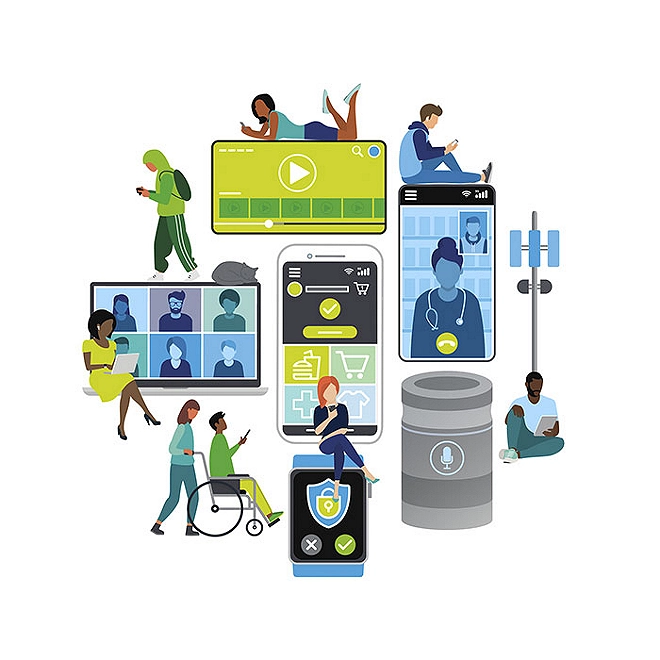Global Mobile Consumer Survey 2019: The Irish cut
The smartphone is now at an inflection point. Adoption rates are nearing their natural peak with 19 out of every 20 adults in Ireland owning one. While ownership rates may be approaching a ceiling, the smart phone economy is just getting started and the smart phone industry is brimming with potential.
While recognising the role the smartphone plays in our lives, this survey draws attention to a number of specific areas, mainly around who and where mobile devices are used and the impact it plays on our lives.
Do females get more use/value from their phones?
Across Ireland, there are no significant differences in smartphone ownership. Smart device ownership is largely consistent with the only ownership variances being in desktops, which are owned by 47% of males in comparison to 36% of females and fitness bands, owned by 29% of females in comparison to 19% of males.
Where we have noted divergence however is in how males and females use smartphones. Across nearly all questions asked, females use their mobile phones more than males.
It is clear from the above data that, overall, females tend to use their phones for a lot more purposes than males do. 43% of male respondents answered 'none of these' compared to 33% of females. Female usage of texting and video calling is also well in excess of male usage.
Location, location, location - the geographical spread of usage
Ownership of connected devices deviate across the country with ownership highest in Leinster followed by Munster and then Connacht/Ulster.
In our view, there are three factors impacting this; demographics, household income and access to broadband. The largest divisions are found between Dublin and Connacht/Ulster.
Indicative difference in device ownership include:
- Smartphone ownership is at 93% across the country apart from Connacht/Ulster where our survey indicated ownership is at 82%.
- Connected devices (for example: smart TVs, games consoles, wireless speakers) ownership is 82% in Dublin and Leinster, 77% in Munster and 69% in Connacht/Ulster.
- Video on demand subscription rates are 64% in Dublin, 55% across Leinster, 59% in Munster and 54% in Connacht/Ulster.
- Despite the divergence in connected devices and smart phones, computer ownership across the country is relatively constant with a rate of 90% in Dublin, 94% in Leinster, 93% in Munster and 88% in Connacht/Ulster.
Acknowledging Nomophobia (the fear of being without our mobile phone)
A trend has been emerging over the past number of years where people are realising that they use their phones too much and are starting to take action to limit their phone usage. Addiction to mobile phones stems from a chemical the body releases called dopamine. When we receive a message on our phone, our body releases dopamine which goes to our nerve endings and gives us a sense of satisfaction that someone wants to interact with us. In checking our phones, there is a chance we will have received a message and our body will release dopamine. In general terms, dopamine is released during pleasurable situations and stimulates us to seek out the pleasurable activity or occupation.
Despite this, in 2017, we reported that 47% of smartphone users felt they used their phone too much and for 2018 and 2019, that figure has risen to 56%.
The battle of the big phone brands
The market share of both iPhone (30%) and Samsung (34%) have increased by a minor amount in the past year (both by 1%). However, Huawei's market share doubled in the past year from 7% in 2018 to 14% in 2019. No other phone brand in Ireland has a market share greater than 3%.
As well as this change, it was found that both age and geographical location had a large bearing over what phone brand a person is likely to own, for example 18-24 year olds are far more likely to own an iPhone than any other age group. iPhones are also more common in Dublin than any other area of Ireland.
The beginning of the end for the PIN?
Although PIN/password authentication is still the most popular method for unlocking phones by far, there is a clear gradual decrease which can be seen in the number of people who use PIN numbers to unlock their phones and authorise transactions of various forms – there has been a 3% decrease in people who use PIN/password authentication, from 81% in 2017 and 2018 to 78% in 2019.
The increase in other methods of biometric authentication available on phones has also increased with fingerprint and voice recognition. Facial recognition and iris recognition all noted as features increasingly available on phones. Fingerprint recognition usage was at 30% in 2017 and is now at 44%. Usage of facial recognition technology in 2017 was 1% and is now at 8%.

